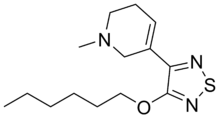From Wikipedia, the free encyclopedia
Xanomeline (LY-246,708 ; Lumeron , Memcor ) is a muscarinic acetylcholine receptor agonist with reasonable selectivity for the M1 and M4 subtypes,[1] [2] [3] [4] M5 receptor antagonist .[5] Alzheimer's disease and schizophrenia , particularly the cognitive and negative symptoms ,[6] gastrointestinal side effects led to a high drop-out rate in clinical trials .[7] [8] learning and short-term memory associated with xanomeline treatment.[9]
See also References
^ Farde L, Suhara T, Halldin C; et al. (1996). "PET study of the M1-agonists [11C]xanomeline and [11C]butylthio-TZTP in monkey and man". Dementia (Basel, Switzerland) . 7 (4): 187–95. PMID 8835881 . CS1 maint: multiple names: authors list (link ) ^ Jakubík J, Michal P, Machová E, Dolezal V (2008). "Importance and prospects for design of selective muscarinic agonists" (PDF) . Physiological Research / Academia Scientiarum Bohemoslovaca . 57 Suppl 3: S39–47. PMID 18481916 . {{cite journal }}: CS1 maint: multiple names: authors list (link )^ Woolley ML, Carter HJ, Gartlon JE, Watson JM, Dawson LA (January 2009). "Attenuation of amphetamine-induced activity by the non-selective muscarinic receptor agonist, xanomeline, is absent in muscarinic M4 receptor knockout mice and attenuated in muscarinic M1 receptor knockout mice" . European Journal of Pharmacology . 603 (1–3): 147–9. doi :10.1016/j.ejphar.2008.12.020 . PMID 19111716 . {{cite journal }}: CS1 maint: multiple names: authors list (link )^ Heinrich JN, Butera JA, Carrick T; et al. (March 2009). "Pharmacological comparison of muscarinic ligands: historical versus more recent muscarinic M1-preferring receptor agonists" . European Journal of Pharmacology . 605 (1–3): 53–6. doi :10.1016/j.ejphar.2008.12.044 . PMID 19168056 . CS1 maint: multiple names: authors list (link ) ^ Grant MK, El-Fakahany EE (October 2005). "Persistent binding and functional antagonism by xanomeline at the muscarinic M5 receptor" . The Journal of Pharmacology and Experimental Therapeutics . 315 (1): 313–9. doi :10.1124/jpet.105.090134 . PMID 16002459 . ^ Lieberman JA, Javitch JA, Moore H (August 2008). "Cholinergic agonists as novel treatments for schizophrenia: the promise of rational drug development for psychiatry" . The American Journal of Psychiatry . 165 (8): 931–6. doi :10.1176/appi.ajp.2008.08050769 . PMID 18676593 . {{cite journal }}: CS1 maint: multiple names: authors list (link )^ Messer WS (2002). "The utility of muscarinic agonists in the treatment of Alzheimer's disease". Journal of Molecular Neuroscience : MN . 19 (1–2): 187–93. doi :10.1007/s12031-002-0031-5 . PMID 12212779 . ^ Mirza NR, Peters D, Sparks RG (2003). "Xanomeline and the antipsychotic potential of muscarinic receptor subtype selective agonists". CNS Drug Reviews . 9 (2): 159–86. doi :10.1111/j.1527-3458.2003.tb00247.x . PMID 12847557 . {{cite journal }}: CS1 maint: multiple names: authors list (link )^ CS1 maint: multiple names: authors list (link )
Template:Nootropics
mAChRs Tooltip Muscarinic acetylcholine receptors
Agonists Antagonists
3-Quinuclidinyl benzilate 4-DAMP Aclidinium bromide (+formoterol )Abediterol AF-DX 250 AF-DX 384 Ambutonium bromide Anisodamine Anisodine Antihistamines (first-generation) (e.g., brompheniramine , buclizine , captodiame , chlorphenamine (chlorpheniramine) , cinnarizine , clemastine , cyproheptadine , dimenhydrinate , dimetindene , diphenhydramine , doxylamine , meclizine , mequitazine , perlapine , phenindamine , pheniramine , phenyltoloxamine , promethazine , propiomazine , triprolidine )AQ-RA 741 Atropine Atropine methonitrate Atypical antipsychotics (e.g., clozapine , fluperlapine , olanzapine (+fluoxetine ), rilapine , quetiapine , tenilapine , zotepine )Benactyzine Benzatropine (benztropine) Benzilone Benzilylcholine mustard Benzydamine BIBN 99 Biperiden Bornaprine Camylofin CAR-226,086 CAR-301,060 CAR-302,196 CAR-302,282 CAR-302,368 CAR-302,537 CAR-302,668 Caramiphen Cimetropium bromide Clidinium bromide Cloperastine CS-27349 Cyclobenzaprine Cyclopentolate Darifenacin DAU-5884 Desfesoterodine Dexetimide DIBD Dicycloverine (dicyclomine) Dihexyverine Difemerine Diphemanil metilsulfate Ditran Drofenine EA-3167 EA-3443 EA-3580 EA-3834 Emepronium bromide Etanautine Etybenzatropine (ethybenztropine) Fenpiverinium Fentonium bromide Fesoterodine Flavoxate Glycopyrronium bromide (+beclometasone/formoterol , +indacaterol , +neostigmine )Hexahydrodifenidol Hexahydrosiladifenidol Hexbutinol Hexocyclium Himbacine HL-031,120 Homatropine Imidafenacin Ipratropium bromide (+salbutamol )Isopropamide J-104,129 Hyoscyamine Mamba toxin 3 Mamba toxin 7 Mazaticol Mebeverine Meladrazine Mepenzolate Methantheline Methoctramine Methylatropine Methylhomatropine Methylscopolamine Metixene Muscarinic toxin 7 N-Ethyl-3-piperidyl benzilate N-Methyl-3-piperidyl benzilate Nefopam Octatropine methylbromide (anisotropine methylbromide) Orphenadrine Otenzepad (AF-DX 116) Otilonium bromide Oxapium iodide Oxitropium bromide Oxybutynin Oxyphencyclimine Oxyphenonium bromide PBID PD-102,807 PD-0298029 Penthienate Pethidine pFHHSiD Phenglutarimide Phenyltoloxamine Pipenzolate bromide Piperidolate Pirenzepine Piroheptine Pizotifen Poldine Pridinol Prifinium bromide Procyclidine Profenamine (ethopropazine) Propantheline bromide Propiverine Quinidine 3-Quinuclidinyl thiochromane-4-carboxylate Revefenacin Rociverine RU-47,213 SCH-57,790 SCH-72,788 SCH-217,443 Scopolamine (hyoscine) Scopolamine butylbromide (hyoscine butylbromide) Silahexacyclium Sofpironium bromide Solifenacin SSRIs Tooltip Selective serotonin reuptake inhibitors (e.g., femoxetine , paroxetine )Telenzepine Terodiline Tetracyclic antidepressants (e.g., amoxapine , maprotiline , mianserin , mirtazapine )Tiemonium iodide Timepidium bromide Tiotropium bromide Tiquizium bromide Tofenacin Tolterodine Tricyclic antidepressants (e.g., amitriptyline (+perphenazine ), amitriptylinoxide , butriptyline , cidoxepin , clomipramine , desipramine , desmethyldesipramine , dibenzepin , dosulepin (dothiepin) , doxepin , imipramine , lofepramine , nitroxazepine , northiaden (desmethyldosulepin) , nortriptyline , protriptyline , quinupramine , trimipramine )Tridihexethyl Trihexyphenidyl Trimebutine Tripitamine (tripitramine) Tropacine Tropatepine Tropicamide Trospium chloride Typical antipsychotics (e.g., chlorpromazine , chlorprothixene , cyamemazine (cyamepromazine) , loxapine , mesoridazine , thioridazine )Umeclidinium bromide (+vilanterol )WIN-2299 Xanomeline Zamifenacin
Precursors (and prodrugs )
nAChRs Tooltip Nicotinic acetylcholine receptors
Agonists PAMs Tooltip positive allosteric modulators )
5-HIAA 6-Chloronicotine A-84,543 A-366,833 A-582,941 A-867,744 ABT-202 ABT-418 ABT-560 ABT-894 Acetylcholine Altinicline Anabasine Anatabine Anatoxin-a AR-R17779 Bephenium hydroxynaphthoate Butinoline Butyrylcholine Carbachol Choline Cotinine Cytisine Decamethonium Desformylflustrabromine Dianicline Dimethylphenylpiperazinium Epibatidine Epiboxidine Ethanol (alcohol) Ethoxysebacylcholine EVP-4473 EVP-6124 Galantamine GTS-21 Ispronicline Ivermectin JNJ-39393406 Levamisole Lobeline MEM-63,908 (RG-3487) Morantel Nicotine (tobacco )NS-1738 PHA-543,613 PHA-709,829 PNU-120,596 PNU-282,987 Pozanicline Pyrantel Rivanicline RJR-2429 Sazetidine A SB-206553 Sebacylcholine SIB-1508Y SIB-1553A SSR-180,711 Suberyldicholine Suxamethonium (succinylcholine) Suxethonium (succinyldicholine) TC-1698 TC-1734 TC-1827 TC-2216 TC-5214 TC-5619 TC-6683 Tebanicline Tribendimidine Tropisetron UB-165 Varenicline WAY-317,538 XY-4083 Antagonists NAMs Tooltip negative allosteric modulators )
Precursors (and prodrugs )

